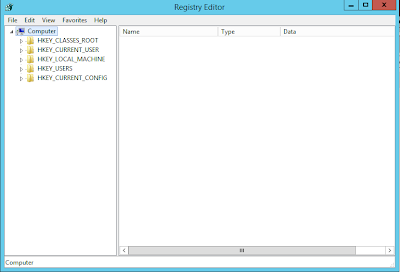Have you been using Oledb to read text files and come across a situation where you want to define each of the columns data types instead of letting it auto define for you. You can actually use a file called Schema.ini and place it in the same folder with the text file that you want to read.
Here's what your schema.ini should contain.
- File name including extension but excludes folder path. The file name is enclosed in a square bracket.
- Whether your file contain header or only data.
- The file format type [csv, tab, etc...]
- The list of columns and its data type.
So let's say in a case where you want all your data types to be in a string format, it will look like the following in your schema.ini.
[Tables.csv]
ColNameHeader=True
Format=CSVDelimited
Col1="Description" Text
Col2=Red Text
Col3=Green Text
Col4=Blue Text
The column defined are in sequences from left to right based on the columns in your text file. So if you did not specify the column sequence correctly, then schema.ini will define the data type wrongly. Also, The column name need to be enclosed in double quotation if it contains a space.
Once finish construct the schema.ini, place it together with the text file that you going to read. Then just read your text file like what you normally did with Oledb. You will notice that the value obtained for each columns are in string.
The following are the code for reading the comma delimited file with header and display it out. It will loop through the comma delimited file content and populate it to the Table class.
[C#]
static void
Main(string[] args)
{
var
tables = ListTables(Path.Combine(Environment.CurrentDirectory,
"TestFile", "Tables.csv"));
foreach
(var table in
tables)
{
Console.WriteLine(string.Format("Description:
{0}", table.Description));
Console.WriteLine(string.Format("Red:
{0}", table.Red));
Console.WriteLine(string.Format("Green:
{0}", table.Green));
Console.WriteLine(string.Format("Blue:
{0}\n", table.Blue));
}
Console.ReadKey();
}
private static List<Table>
ListTables(string fileName)
{
var
tables = new List<Table>();
var
fileInfo = new FileInfo(fileName);
const string
SQL_STATEMENT = "SELECT * FROM [{0}]";
using
(var con = new OleDbConnection(string.Format("Provider=Microsoft.ACE.OLEDB.12.0;Data
Source={0};Extended Properties='text; HDR=YES;'",
fileInfo.DirectoryName)))
{
con.Open();
using
(var cmd = new OleDbCommand(string.Format(SQL_STATEMENT,
fileInfo.Name), con))
{
using
(var reader = cmd.ExecuteReader())
{
while
(reader.Read())
{
var
table = new Table();
table.Description =
reader.GetValue(reader.GetOrdinal("Description")).ToString();
table.Red =
reader.GetValue(reader.GetOrdinal("Red")).ToString();
table.Green =
reader.GetValue(reader.GetOrdinal("Green")).ToString();
table.Blue =
reader.GetValue(reader.GetOrdinal("Blue")).ToString();
tables.Add(table);
}
}
}
}
return
tables;
}
[VB]
Sub
Main()
Dim
tables As List(Of Table)
= ListTables(Path.Combine(Environment.CurrentDirectory,
"TestFile", "Tables.csv"))
For Each
table As Table In
tables
Console.WriteLine(String.Format("Description:
{0}", table.Description))
Console.WriteLine(String.Format("Red:
{0}", table.Red))
Console.WriteLine(String.Format("Green:
{0}", table.Green))
Console.WriteLine(String.Format("Blue:
{0}" + Environment.NewLine,
table.Blue))
Next
Console.ReadKey()
End Sub
Private Function
ListTables(ByVal fileName As String)
As List(Of Table)
Dim
tables As List(Of Table)
= New List(Of Table)
Dim
fileInfo As FileInfo
= New FileInfo(fileName)
Const
SQL_STATEMENT As String
= "SELECT * FROM [{0}]"
Using
con As OleDbConnection
= New OleDbConnection(String.Format("Provider=Microsoft.ACE.OLEDB.12.0;Data
Source={0};Extended Properties='text; HDR=YES;'",
fileInfo.DirectoryName))
con.Open()
Using
cmd As OleDbCommand
= New OleDbCommand(String.Format(SQL_STATEMENT,
fileInfo.Name), con)
Using
reader As OleDbDataReader
= cmd.ExecuteReader()
While
reader.Read
Dim
table As Table
= New Table()
table.Description =
reader.GetValue(reader.GetOrdinal("Description")).ToString()
table.Red =
reader.GetValue(reader.GetOrdinal("Red")).ToString()
table.Green =
reader.GetValue(reader.GetOrdinal("Green")).ToString()
table.Blue =
reader.GetValue(reader.GetOrdinal("Blue")).ToString()
tables.Add(table)
End While
End Using
End Using
End Using
Return
tables
End Function
This example is just to demonstrate how you can define each of the columns' data type. It is advisable to define a correct data type for the column, so that you don't have to do unnecessary data conversion.
If you get hit with the error "The 'Microsoft.ACE.OLEDB.12.0' provider is not registered on the local machine.". Please install
Microsoft Access Database Engine 2010 x86.
More on how to construct your own Schema.ini can be found on the following link :
http://msdn.microsoft.com/en-us/library/ms709353(VS.85).aspx
Source code can be obtained here:
https://onedrive.live.com/redir?resid=E6612168B803803D!355&authkey=!AOcpGnFSW310zJ0&ithint=file%2czip
Github:
https://github.com/Jaryllan/Demonstration-Oledb-With-Schema
































